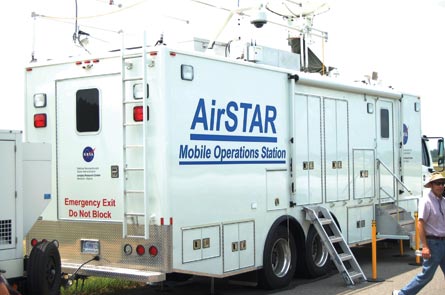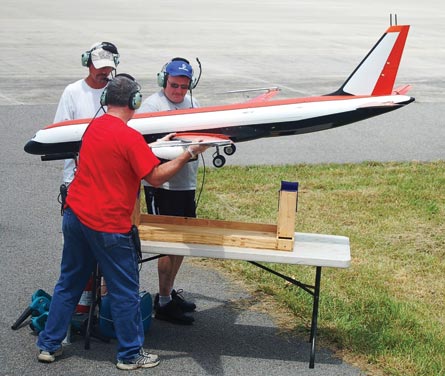To see the modern equipment and hear the dozen engineers and researchers prepping for the "show", the four-compartment portable operations centre we visited on 2 June could have been at the heart of any aeronautical flight-test programme about to carry people to the outer edges of the envelope.
A look at the video monitor in the top-left position of the command station console, showing the action happening outside the mobile operations station, painted the activity in a slightly different - and more relaxing - light, however. The aircraft outside was about to carry men and women to the outer edges of the envelope, but only vicariously.
We had travelled to Fort Pickett airfield in Virginia on 2 June to witness test flight 19 of NASA's second "generic transport model", T2, a fully controllable, instrumented and dynamically scaled jet-powered - but unmanned - research aircraft, one of several used in the agency's airborne subscale transport aircraft research testbed (Airstar), a programme being run by the NASA Langley Research Center.
|
|---|
While modern aircraft are designed to avoid such extreme pitch, roll and yaw environments, situations such as wake turbulence, sensor errors or other unintended consequences can lead to an upset for which pilots have not been prepared.
Airline pilot training today is largely based on full-flight simulators that are calibrated to a fairly limited flight-verified and windtunnel tested envelope. Since there is typically no data on which to model handling characteristics in extreme attitudes and post-stall regions, simulators and the pilots flying them can not train in that regime, creating a situation where pilots may experience a condition in flight for which they have not previously trained.
Two realistic methods are available for getting the data that could expand simulators into the upset regime - taking more windtunnel testing with a subscale model, or taking that subscale model out of the windtunnel and into the atmosphere. The latter is part of the genesis of Airstar, a "mobile in-flight windtunnel" built as part of NASA's aviation safety programme. Along with boosting the fidelity of simulators, Airstar is also being used as a rapid prototyping testbed for new flight-control algorithms, real-time parameter identification and integrated vehicle health management.
The 2 June T2 flights would focus on real-time parameter estimation and a University of Illinois / University of Connecticut flight-control algorithm designed to give pilots several seconds of control on an otherwise uncontrollable aircraft (see P30). Flights would start with a safety pilot Lou Glaab, with standard radio control handheld controller, performing the take-off, followed by handover to research pilot Dan Murri sitting at the flightdeck control station in the mobile operations station, complete with standard flightdeck displays and synthetic vision. The mobile also has separate stations for engineering, communications and research.
Research pilots use test cards for the flights. Under NASA's unmanned air vehicle certificate of authorisation, T2 is required to stay within a 1 mile (1.6km) radius of the runway and below 2,500ft (760m). The safety pilot maintains eyes on the aircraft at all times and can intervene if there is a potential conflict with another aircraft. A typical flight includes 10-12 manoeuvres, says Murri. Adaptive control algorithms built by the George Institute Technology and the Massachusetts Institute of Technology were due to be tested as well.
T2 is not a typical radio-controlled aircraft. To match the aerodynamic performance of a large transport aircraft, similar in shape to NASA's Boeing 757 test aircraft, the "generic transport model" weighs 25kg (54lb) to simulate a 90,720kg aircraft.
The small size also requires that the aircraft's 16 control surfaces respond more than four times faster than for the full-size aircraft. The model is scaled to about 5.5%, largely to match a windtunnel model for which NASA Langley has already tested. In addition, as a result of the scaling, aerodynamics results from the tests are considered valid only for mach numbers less than M0.45.
T2, with a 208cm (82in) wingspan, typically "cruises" at 85kt (157km/h) and 1,100ft (335m) on twin turbojet engines that produce 26lb thrust (0.115kN) each as it flies circular or figure-eight patterns in the test area between manoeuvres. On board is a redundant micro inertial reference system, air data probes on each wing tip and potentiometers to measure control surface movements. Commands from the research pilot in the mobile operations station are converted to control surface and engine commands and passed to the aircraft via radio frequency link.
Built into each of the planned test flights for the test campaign was a system identification process developed by Langley researcher Gene Morelli. Called Morelli sweeps, the process injects small control deflections to multiple surfaces simultaneously at different frequencies, allowing researchers to quickly determine an aerodynamic representative model that, when joined with other models at other flight conditions, can be used to characterise an aircraft much faster than previously. A validated model could be used as the basis for a simulator that offers true upset recovery capability.
With test cards at the ready, operators divided between the mobile operations station and a work table near the runway's edge, initiated the engine starts. With a simulated turbine whine humming in our headsets in the mobile operations station, operators performed several full-power run-ups before giving technicians outside the go-ahead to carry T2 on to the runway centreline for take-off.
An out-of-range exhaust gas temperature signal from the left engine, however, scuttled the sortie. The team replaced the engine and repaired certain wiring harnesses for the next day's flight, a fix that was successful. Four flights were logged on the second day, and five on the final day, the highest number to date.
|
|---|
BUYING PRECIOUS TIME
In the emergency medical services field, experts speak of the "golden hour", the time within which a seriously wounded patient has a better chance of survival if rushed to an emergency room.
In a transport aircraft that has been upset, there is an equivalent concept when it comes to the potential for recovering control and saving many lives, except that the "hour" is actually "seconds". Researchers at the University of Illinois at Urbana-Champaign and University of Connecticut have developed an adaptive flight-control algorithm that could do just that - give the pilot of an otherwise uncontrollable aircraft just a few extra seconds of controllability, enough to give him or her time to save the vehicle from a loss-of-control accident.
NASA Langley researchers flew Illinois and Connecticut's L1 adaptive controller recently in its Airstar subscale flying testbed, putting the algorithm to the test during post-stall high angle-of-attack scenarios. Adaptive controls take advantage of every available control surface to follow the pilot's commands despite the state of the aircraft.
Langley senior researcher Irene Gregory explains that historically, adaptive control algorithms could guarantee stability in steady-state operations only, not during transients.
A new version of adaptive control called "L1", however, can predict transient behaviour. "That's a really big deal," says Gregory, "to know what will happen in the first seconds after a transient." NASA worked with Illinois to test the new algorithm on its subscale model to help research pilots maintain control of the aircraft when it departs the nominal operating envelope, a realm the device is intended to probe often. It is not too far of a leap to imagine such algorithms being used on commercial transport aircraft for the same purpose.
During testing of the T2 subscale generic transport model from 2-4 June at Fort Pickett airfield in Virginia, the algorithm proved its worth. Gregory says one of the test cards called for the research pilot put the aircraft at a post-stall angle-of-attack without and then with the L1 controller. She explains that the research pilot's job was to put in step input of positive elevator at the post-stall AoA and attempt to hold the aircraft there. Without L1, "he couldn't hold the aircraft", she says. "It was rolling and slicing, exceeding 45° bank."
Using the L1 control law in the same manoeuvre however, she says the pilot was able to hold the nose-high attitude for 3-4s and bank angles never exceeding 20°. "It bought him time to make a proper recovery," she says.
|
|---|
Source: Flight International


























